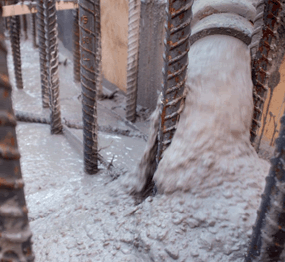The science of how a material like concrete flows is called rheology. Traditionally, workability has been defined by slump, hut mixes with the same slump can behave very differently (have different rheology), especially when the mix includes water-reducing admixtures. The theological properties of fresh concrete include its yield stress and viscosity, which together define workability and how easy a concrete will consolidate. Rheology is something every concrete person should understand.
Stiff, low-water concrete mixes are intended to achieve high strength and low permeability, but without good consolidation these objectives can’t be achieved. Added water will allow easier consolidation but lower the strength of the mix. Fluidity can be achieved with admixtures, most notably superplasticizers (or high-range water reducing adrnixtures), but these admixtures are expensive and not always necessary with good consolidation technique.
With more fluid concrete and when placing flatwork, manually pushing and tamping the concrete or banging on the outside of the forms can usually remove most of the entrapped air. Stiff, low water content mixes, though, require more effort. With most formed concrete, mechanical consolidation is the best way to improve the quality of the work. Consolidation isn’t difficult, but can be ineffective without the proper equipment and technique. Here are some tips to improve your concrete through consolidation.
With more fluid concrete and when placing flatwork, manually pushing and tamping the concrete or banging on the outside of the forms can usually remove most of the entrapped air. Stiff, low water content mixes, though, require more effort. With most formed concrete, mechanical consolidation is the best way to improve the quality of the work. Consolidation isn’t difficult, but can be ineffective without the proper equipment and technique. Here are some tips to improve your concrete through consolidation.

Fluidity can be achieved using superplasticizers,
but they are expensive and not always necessary with good consolidation technique
No comments:
Post a Comment